The DF83V is the latest and greatest grinder from the company behind the popular DF64 model.
Having used this grinder daily for several months now, I’ve put it through its paces brewing filter coffee and espresso using various burr sets and a wide range of beans.
Read on for my take on whether this grinder lives up to its promise as a potential “budget endgame” option.
The cheapest of the “titans”
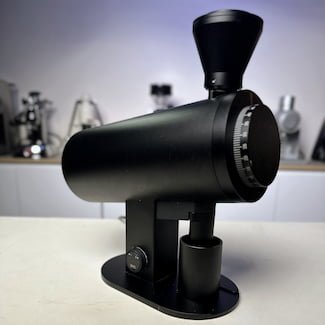
The new model from the DF-brand is their most ambitious product to date. It offers huge burrs, RPM control and a prebreaker/auger at lower price than the competition.
MiicoffeeHeads up: I received a review unit from Miicoffee who is one one of the importers in North America. The shop hasn’t had any editorial influence on the review.
✅ Pros:
- New vertical burr design with auger/pre-breaker. This enhances grind consistency and makes the same burrs “perform” better than in the old DF83.
- 83 mm “commercial sized” burrs that are easy to swap for other burrs brands such as SSP and Mazzer.
- Variable speed control, ranging from 300 to 1600 RPM
- “Modern” single dose grinder with: low retention, a big adjustment dial, and features like the tool-free burr access and magnetic chute.
- Improved noise level with a quiet brushless motor.
- Offers a robust power setup with a 680W brushless motor, providing enough strength to handle a variety of beans without stalling, particularly at higher RPM settings.
❌ Cons:
- The design includes a bulky backlit power button and other elements that may seem out of place.
- Lacks portafilter forks, which could be a drawback for users who prefer direct grinding into a portafilter for espresso.
- New and untested burr chamber/spring mechanism: Durability and long-term reliability could be a concern.
- The price point, particularly when considering additional expenses for premium burr upgrades. Much more expensive compared to equivalent 64 mm burrs.
ABOUT THE BRAND
When the DF64 burst onto the scene in 2021, it was like a surprise guest at a dinner party – equal parts exciting and perplexing.
On one hand, it made 64mm flat burr single-dosing cheaper and more widely available than ever before. But on the other hand, some of its design choices were as confusing as a David Lynch film. I mean, that font? It was like the typographic equivalent of putting pineapple on pizza.
Well… except for the fact that in this instance nobody was secretly loving it 🙅
From the get-go, it was clear that “DF64” referred to a grinder design rather than a specific brand. These grinders are made by one or more unnamed OEMs in China and sold under a dizzying array of brands like G-IOTA, Miicoffee, Solo, Zentis, or Turin.
The exact factory (or factories) behind it remains a mystery – some say Zhejiang Feilai Electric Appliance, others point to Ningbo Frigga.
Despite some early quirks and quality control issues, the DF64 had undeniable momentum. The brand (or brands?) quickly iterated with the DF64V and Gen 2 models, refining the design and fixing early flaws.
(I actually think both these models were incredibly solid successors.)
But the real surprise was when they doubled down and went even bigger with the original DF83 – a beastly 83mm flat burr single-doser. As the young people would say; they went from Chad to Giga Chad.
Most reviews – including mine – were largely positive. But the brand apparently saw room for improvement, because they’ve now launched a new and completely redesigned DF83V.
The “V” presumably stands for variable speed – a feature that’s still rare in flat burr single-dosers and gives users more flexibility to experiment with grind speed.
DF83 (left) and it’s sibling DF83V looks nothing alike


DESIGN
The DF83V sports a brand new design that’s a significant departure from previous DF grinders. Earlier models all shared a “standard” design with burrs mounted horizontally (like two pancakes stacked on top of each other).
The new grinder instead has a vertically mounted set of 83 mm flat burrs and it’s fed via augers that rotate and push the beans into the burrs.
This design is also used on recent smash hit models such as the Fellow Ode and Timemore Sculptor.
I have the the black version and think it looks reasonably cool and modern. It’s also available in silver. DF-grinders are probably never going to win any design awards, but I think this is the most striking and unique product they have made.
It’s a big boy, though. It takes up a lot of space on the counter and really looks like something that belongs in a café rather than in a home.
The finish is not quite matte and not quite shiny. It’s somewhere in-between, which means that it’s neither ostentatious nor a finger/dust magnet like certain new hipster coffee products.
At around 22 lbs, this is a hefty grinder with a solid, well-constructed feel. The body is predominantly made of metal.
Aesthetics?
- Main Power Switch: The chunky main power switch is backlit in a striking red color, which can detract from the grinder’s otherwise sleek appearance. I would have preferred a more discrete button, but it’s not a major concern in daily use.
- RPM Indicator: This feature is identical to the one on the DF64V. However, on the DF83V, it appears less out of place as there are no other font types, minimizing design clashes. And because the whole grinder is so much larger than the 64 mm version, it feels smaller and more integrated.
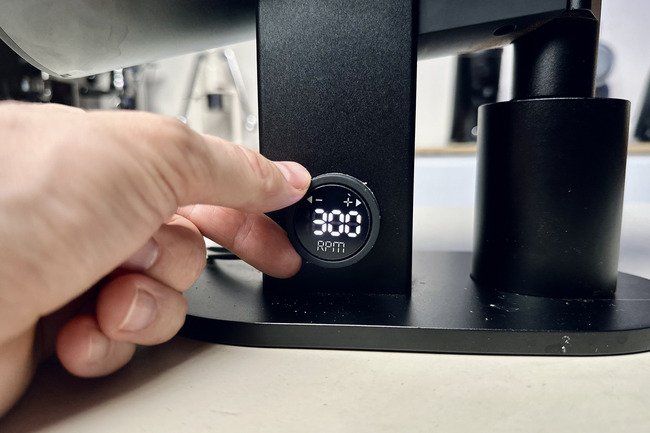

- Adjustment Dial: The aluminum adjustment dial is well-designed, offering smooth operation and precise readings. It’s easy to adjust and secure at your desired zero point.
- Magnetic Catch Cup: The catch cup is magetic and there’s a practical cutout in the base of the grinder for ease of fitting. Although functional, a differently colored interior would have been more practical, so it’s easier to check for any leftover coffee grounds stock in the bottom edges.

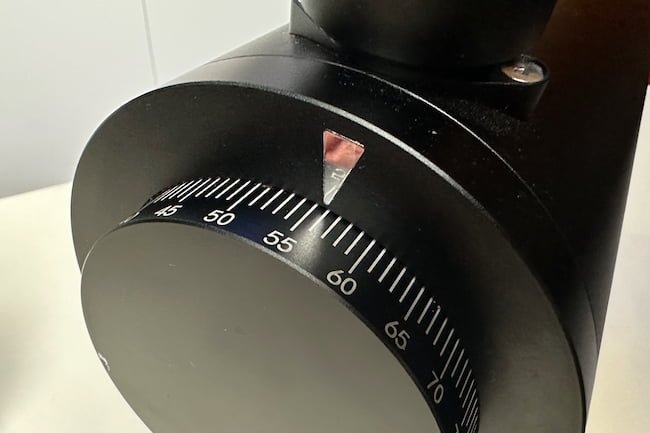
DAILY USE
Using the DF83V is a pretty nice experience. This first thing that strikes you is how fast the grinder operates.
Of course, this also depends on the RPM that you grind at and the burrs you have installed. If you’re running the grinder at a typical speed of 1400 RPM a shot can be ground in around 4-5 seconds. That’s fast!
The motor spins at an adjustable speed from 300-1600 RPM, with a slightly slow start before it hits the target speed.
Grind quality is excellent across a wide range of settings thanks to the 83mm DLC-coated flat burrs and pre-breaking system that feeds beans smoothly into the burrs with minimal popcorning.
I’ve measured retention at around 0.2-0.5g in most cases, with virtually zero retention when using the included bellows attachment. Even though there’s a plasma generator built in you could still see some signs of static, so if you want a completely mess-free experience it’s still a good idea to use a little spray of water (aka RDT).
Cleaning is refreshingly easy, with tool-free access to the burrs via the splittable grind chamber and a removable magnetic chute for dealing with any stray grounds.
Sound-wise the grinder is also decent. The brushless motor is very quiet when running. Once you dump in the beans then it will be noisy on par with most regular single dose grinders. Of course, this also depends a lot on the burrs and grind speed selected.
Like all the other DF-grinders it’s very easy to take apart and swap burrs. Alignment was excellent out of the box with my unit.
I appreciate that there’s a separate button for power and on/off. This means that you can turn off the grinder completely and not draw power when it’s not in use. Plus, the RPM display and backlit on/off button won’t shine bright in the nighttime (unneccesary bright displays and light indicators are a pet peeve of mine in case you hadn’t noticed!).
Overall, I will say that the DF83V performs well in these typical quality of life aspects. As a modern single dose grinder it’s performing as expected. It’s flexible across various brewing methods, has low retention and is not particularly annoying or messy.
Is stalling a problem?
The DF83V has handled everything from light, dense filter roasts to classic Italian espresso beans without any sign of stalling or struggle during my testing period.
I did see other reviews mentioning that the grinder stalled with lighter roasts on the 300 RPM setting with a cold start.
Maybe this is because I use a 220V version and those reviewers had 110V versions.
But still I think stalling is a rare issue for most regular users. Here’s why:
- If you’re grinding at RPMs below 600 it’s wise to use a hot start (turn on the motor BEFORE you dump in the beans) this will reduce the likelihood of stalling.
- Most reports of stalling has been with ultra-fine settings at low RPMs. But a realistic use case is operating the grinder at +1000 RPM when grinding for espresso.
The brushless motor in the DF83V is super powerful at 680 W. This motor and the auger/prebreaker mechanism means that the grinder is a lot less likely to be overwhelmed than the DF64V, which could occassionally stall with very light roasts at lower RPMs. The narrative around the DF64V has been a bit fuzzy due to this. However, in reality I have not faced this issue at all ever since I changed to SSP MP and SSP Cast burrs. With the DF83V it shouldn’t be a concern at all if you ask me.
Imagine if you have a powerful blender. If you put a bunch of big chunks of raw carrot in there and try to turn it on, it might refuse. But use it as intended (more liquid, smaller bits, or add the pieces gradually while the device is running) then you’re good.
Downsides
There are a few unique downsides to the grinder I want to touch upon.

- Messy hopper: Even though there is a an antipopcorn disk in place in the hopper some grounds can still get “shot” back up and get stock inside the hopper. The popcorn disk mainly work to keep larger shrapnels down in the grinding chamber. But it seems like crushing and spinning mechanism of the auger has a tendency to send this dust back up into the system, so there will be some build up over time.
- Lack of portafilter forks: The DF83V does not have portafilter forks or any accessories that allow for directly grinding into the portafilter, which some espresso-focused users will probably see as a downside. I like using a catch cup, however, so for me this is no big deal.
- Unknown spring mechanism: The burr chamber is also a completely new design. Initially, I was a bit sceptical about the springs that create the resistance between the two burrs carriers – they just look a bit flimsy somehow. But the other side of the equation is that if the springs were more beefy then it would be more challenging to adjust the grind size. And currently it’s just about the right resistance. More than this would make it uncomfortable to use.
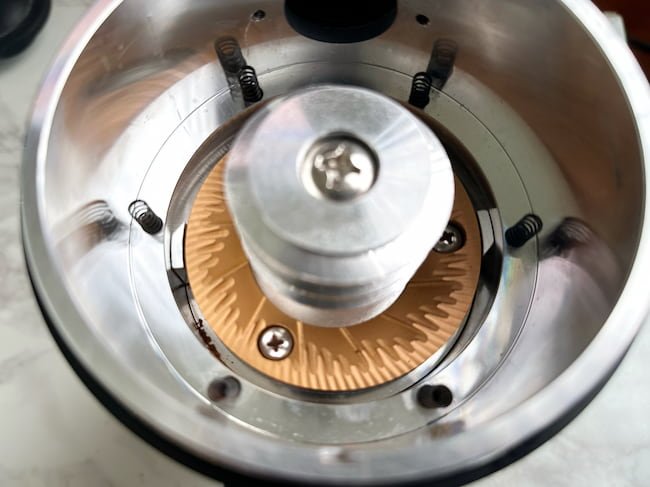
On the original DF64 you had 3 more beefy springs. Here you have 6 slightly more fragile springs. I assume this will be better for alignment, but it’s hard to say what condition they will be in after a few years of use. It’s not a “true” downside but just something that’s worth flagging as a potential concern.
Stock burrs and flavor profile
Out of the box, the DF83V’s DLC-coated stock burrs are very capable, producing a “professional” tasting espresso shot with plenty of body, texture, and a reasonable amount of clarity. If you were served an espresso shot like this in a coffee shop, you wouldn’t think twice. It’s solid.
The burrs also work pretty well for pour over when running at low RPMs around 300-600. Discerning snobs who have experience with unimodal flats or high end hand grinders will like want a touch more clarity and acidity, but for the vast majority of people it should be fine. I’d say the burrs are better for pour over than both the Baratza Encore and the stock burrs in Wilfa Uniform. So yes, better than what many people consider “the standard”.
Overall, they are safe burrs that taste good with a wide variety of beans and brewing methods. For most users, there’s likely no need to upgrade.
My grinder also came with a set of pour over burrs, but I didn’t experiment much with them. While these burrs have an unusual and cool design, I don’t think most people buy this type of grinder as a dedicated pour over grinder. At this price and size, my guess is that most people are looking for a multipurpose grinder or at the very least an espresso grinder.
But there was another reason I didn’t spend much time with the pour over burrs: I was simply too curious about how my 83mm SSP Lab Sweet/cast burrs would perform in the grinder. And I was not disappointed!

DF83V vs the old DF83
I had previously used these burrs in the standard DF83 released back in 2022. While I really enjoyed the burrs in that grinder, I was surprised to find that I liked them even more in the DF83V.
Somehow, the pour over had more clarity and complexity, and the espresso seemed better too. The SSP 83LS burrs are what I would call a truly great set of all-rounder burrs. They make pour over taste big and bold but still with plenty of acidity and flavor clarity. At the same time, they make sweet, clarity-forward espresso shots with that special texture you only really get with cast burrs.
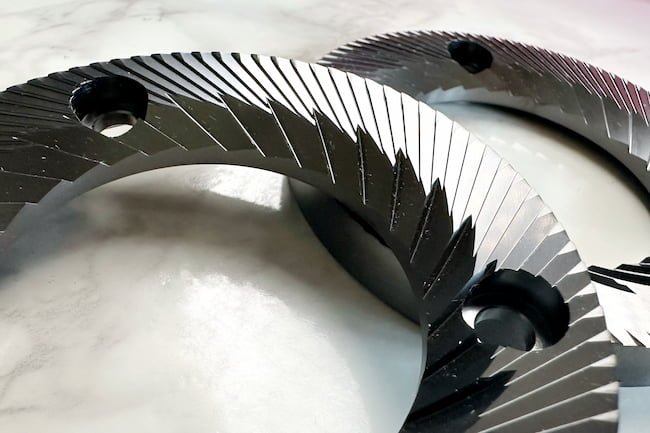
The fact, that these burrs were suddenly tasting even better than before is, for me, a pretty clear indication that the way the beans are fed into the DF83V makes a difference compared to the traditional design. With the standard DF83, there can be a noticeable amount of popcorning. With the auger-fed design, the beans are fed into the burrs at a more predictable rate, while some of them are also crushed before entering the burrs. Some of my coffee colleagues on YouTube have run tests to show how big an amount of beans are crushed by the auger – while it’s not crushing 100% of the beans, it’s still a non-negligible amount.
I buy the theory that beans might spend longer and be ground in a more random manner in the standard horizontal burr chamber – it would certainly explain my experience. This highlights the DF83V’s strength as a platform for burr swaps. The improved design and auger-fed system seem to bring out the best in aftermarket burrs like the SSP 83LS.
If you’re set on an 83mm grinder and you plan to swap in premium burrs, the DF83V is the best base to build on right now. Its design improvements, variable speed, and auger system seem to really let those high-end burrs shine.

Burr upgrade options
However, the cost of the DF83V plus SSP burrs is not for coffee lovers on a budget. The DF83 by itself is what most people would consider an expensive grinder. If you add 83 mm burrs to that bill you could get two (2!) DF64 Gen 2 grinders, each with SSP burrs installed (one for espresso and one dedicated to filter) for the same price
Or you could get an 1Zpresso K-Ultra for pour over paired with a DF64 Gen 2 with SSP HU burrs and pocket the change, which would be substantial.
So while the DF83V is a fantastic grinder and an excellent platform for 83mm burr swaps, it’s not necessarily the most flexible or cost effective option. A setup built around 64mm grinders offers more versatility and bang for your buck, especially considering the wide range of aftermarket burr options available in that size.
At the moment of writing, SSP offers three (sometimes four) 83mm burr sets available: the espresso-focused HU, the allrounder Cast/Lab Sweet, and the notoriously tricky MP burrs, which is a clarity-forward allrounder. There have also been mentions of people who have bought a limited edition brew burr inspired by Ditting’s 805 Tanzania burr.
All of these are priced around the $400 mark, so they’re definitely a significant investment. For that reason there’s also less of a consensus around these burrs compared to their 64 mm counterparts, which are much more common. I can say that I fully enjoy the 83 mm Cast version and think they are better than their 64 version; especially when it comes to espresso.
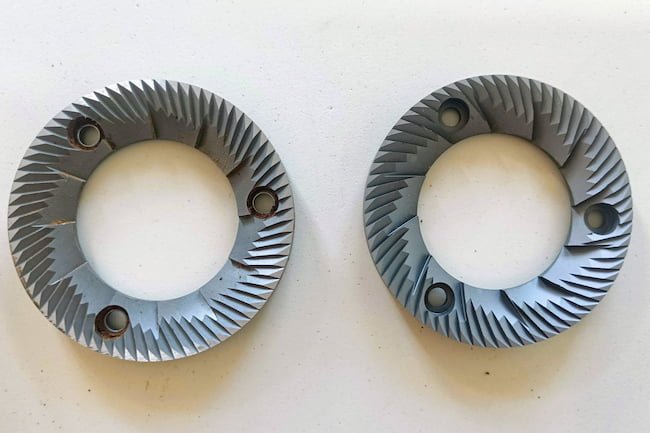
I have also heard good things about the 83 mm HU version for espresso, while the response to the MP burrs seems a bit more lukewarm.
Mazzer, one of the oldest and most respected names in commercial grinders, also offers a range of burrs in this size.
Mazzer’s 83mm burrs are generally less expensive than SSP’s – you can often find them for around half the price or even less. However, they also tend to be more traditional in their design and flavor profile. They’re not as clarity-forward as the SSP burrs, but they can be a good choice if you prefer a more traditional espresso shot or are mostly brewing darker roasts. For pour over, the Mazzer burrs are less exciting. Or at least that’s my opinion of the 151F model, which I tested extensively in the old DF83 version.
CONCLUSION
The DF83V is an exciting and remarkably full-featured grinder that delivers top-tier flat burr performance at a price that, while not cheap, substantially undercuts other bulky “Titan” grinders.
When it comes to espresso, it’s a very capable performer for straight shots and milk drinks, with the potential to get even better with the optional SSP burr swap.
Build quality is very high overall, and DF has done an admirable job keeping retention low. The innovative tool-free burr access and easy cleaning are also very welcome.
At my home, the DF83V has pretty much taken over as my daily go-to grinder. While the design and UX is not necessarily better than many other grinders in my collection it just offers a nice package with everything I wish for. The workflow is nice, RPM is cool, and retention is relatively low. It’s super fast due to the big burrs. The noise level is also very acceptable.
And then with the SSP Lab Sweet burrs installed I just get a very consistent cup profile that on average delivers the best coffee of any grinder in my collection. For pour over it’s more or less impossible to make a bad cup of coffee and for espresso it offers a nice middle-ground between exciting and traditional.
So as a “platform” for a truly great set of 83 mm burrs, the new DF83V just performs very well.
If you’re in the market for an endgame-quality grinder but can’t stomach the heft price of the more “boutique” brands – then the DF83V should absolutely be on your shortlist.
But if you don’t mind (or actually desire) two grinders each dedicated to filter and espresso, then that solution might be both cheaper and better for your use case.
➡️ Check current price on Miicoffee
